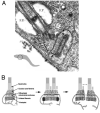The developmental cell biology of Trypanosoma brucei
- PMID: 15654017
- PMCID: PMC2686837
- DOI: 10.1242/jcs.01649
The developmental cell biology of Trypanosoma brucei
Erratum in
- J Cell Sci. 2005 May 1;118(Pt 9):2078
Abstract
Trypanosoma brucei provides an excellent system for studies of many aspects of cell biology, including cell structure and morphology, organelle positioning, cell division and protein trafficking. However, the trypanosome has a complex life cycle in which it must adapt either to the mammalian bloodstream or to different compartments within the tsetse fly. These differentiation events require stage-specific changes to basic cell biological processes and reflect responses to environmental stimuli and programmed differentiation events that must occur within a single cell. The organization of cell structure is fundamental to the trypanosome throughout its life cycle. Modulations of the overall cell morphology and positioning of the specialized mitochondrial genome, flagellum and associated basal body provide the classical descriptions of the different life cycle stages of the parasite. The dependency relationships that govern these morphological changes are now beginning to be understood and their molecular basis identified. The overall picture emerging is of a highly organized cell in which the rules established for cell division and morphogenesis in organisms such as yeast and mammalian cells do not necessarily apply. Therefore, understanding the developmental cell biology of the African trypanosome is providing insight into both fundamentally conserved and fundamentally different aspects of the organization of the eukaryotic cell.
Figures





References
-
- Amiguet-Vercher A, Perez-Morga D, Pays A, Poelvoorde P, van Xong H, Tebabi P, Vanhamme L, Pays E. Loss of the mono-allelic control of the VSG expression sites during the development of Trypanosoma brucei in the bloodstream. Mol. Microbiol. 2004;51:1577–1588. - PubMed
-
- Bastin P, Sherwin T, Gull K. Paraflagellar rod is vital for trypanosome motility. Nature. 1998;391:548. - PubMed
-
- Bochud-Allemann N, Schneider A. Mitochondrial substrate level phosphorylation is essential for growth of procyclic Trypanosoma brucei. J. Biol. Chem. 2002;277:32849–32854. - PubMed
-
- Briggs LJ, McKean PG, Baines A, Moreira-Leite F, Davidge J, Vaughan S, Gull K. The flagella connector of Trypanosoma brucei: an unusual mobile transmembrane junction. J. Cell Sci. 2004;117:1641–1651. - PubMed
Publication types
MeSH terms
Grants and funding
LinkOut - more resources
Full Text Sources
Other Literature Sources

